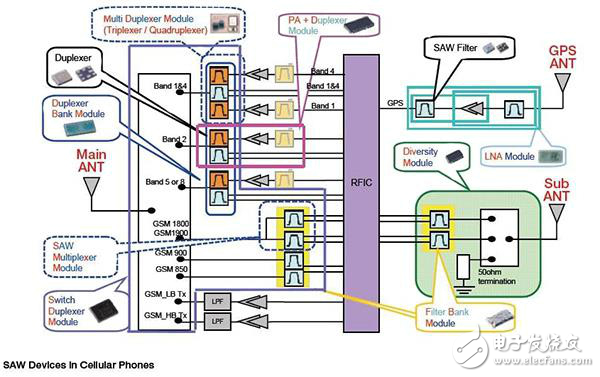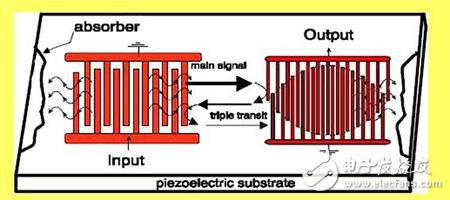
资料下载

SAW滤波器救援无线产品的分立方案
SAW Filters Rescue Wireless Products from Impractical Discrete Implementations
作者:Bill Schweber
Filters have always been an essential component in the RF signal path. In the past, engineers had to become skilled in the complexities of filter-design theory and practice in order to create real filters based on discrete components. However, for today’s wireless devices and applications, the required filter specifications are increasingly difficult to meet using this approach as the RF spectrum gets more crowded and is sliced into smaller slivers, while operating frequencies increase well beyond the GHz threshold. The reality is that filters using discrete components cannot meet the performance, consistency (due to parasitics), size, and cost needs of many of today’s RF products.
Fortunately, monolithic-like devices such as surface acoustic wave (SAW) filters were developed over the last decades, and these provide the needed functions and features. With SAW filters, engineers are primarily concerned with selection of the filter as a single complete entity, instead of filter design. SAW filters offer a favorable combination of performance, size and cost, and are used extensively in applications embodying Wi-Fi, LTE, GSM, Bluetooth, and many other wireless standards.
A multiband smartphone can have ten or more SAW filters, fulfilling many roles: wideband, narrowband, passband, low pass, and high pass, at both the system -level, as well as in highly localized sub-circuits (Figure 1)。 As a result, the filter-related activity of engineers has shifted from working through a complex design and associated test/debug to, instead, the selection of a suitable, available filter (which is a good thing, to most engineers)。

Figure 1: SAW filters are used in quantity in wireless devices, for front-end filtering, narrow multiband filtering, and eliminating specific interference sources; they can be narrow or wide, with band-pass, low-pass, and high-pass FIR characteristics. (Courtesy of Taiyo Yuden)
SAW filter basics
A SAW device transforms the electronic RF-signal energy to mechanical energy in the acoustic domain. The filter is based on a piezoelectric material used as a substrate, such as quartz, lithium niobate, lithium tantalate, or lanthanum gallium silicate. Both ends of this substrate are capped with a sculpted metal layer as the electro-acoustic transducer, formed from comb-like fingers as an interdigital transducer (IDT), as illustrated in Figure 2.

Figure 2: Comb-like interdigital transducers at each end of the piezoelectric substrate convert impinging electrical energy to acoustic-mechanical energy, the energy wave then travels across the surface, where it is converted back to electrical energy by an IDT at the receiving end. (Courtesy of the University of South Florida)
The electrical signal is applied to one end of the device, converted to acoustic energy by the source IDT and launched across the piezo material’s surface, where it travels as surface-acoustic wave (called Rayleigh waves after Lord Rayleigh, who analyzed them in detail)。 The energy is then converted back to an electronic signal at the far end by a similar though not identical IDT, designed to capture the energy. Fortunately, the overall electrical/acoustic and complementary acoustic/electrical conversion processes are highly-efficient, reaching 99% or better; this helps maintain SNR and signal integrity.
The SAW filtering results from constructive and destructive interference, due to the wave delays which occur as the wave travels across the surface at between 3000 and 12,000 meters/second (depending on substrate material)。 The delayed outputs at the receiving end combine, yielding a finite-impulse-response (FIR) filter response. The acoustic energy’s propagation speed is far, far slower than electrical propagation, and thus has mechanically viable dimensions. By adjusting the travel distance and dimensions of the IDT fingers, and thus their impulse response, the standing-wave interference pattern of the SAW device establishes a desired filter center frequency, bandwidth, type, and other factors.
Note that the SAW is completely different in fundamental concept and implementation than a traditional all-electronic, RLC-based filter; it is not just an integrated-circuit, monolithic re-creation of the RLC-type
声明:本文内容及配图由入驻作者撰写或者入驻合作网站授权转载。文章观点仅代表作者本人,不代表电子发烧友网立场。文章及其配图仅供工程师学习之用,如有内容侵权或者其他违规问题,请联系本站处理。 举报投诉
- 相关下载
- 相关文章






